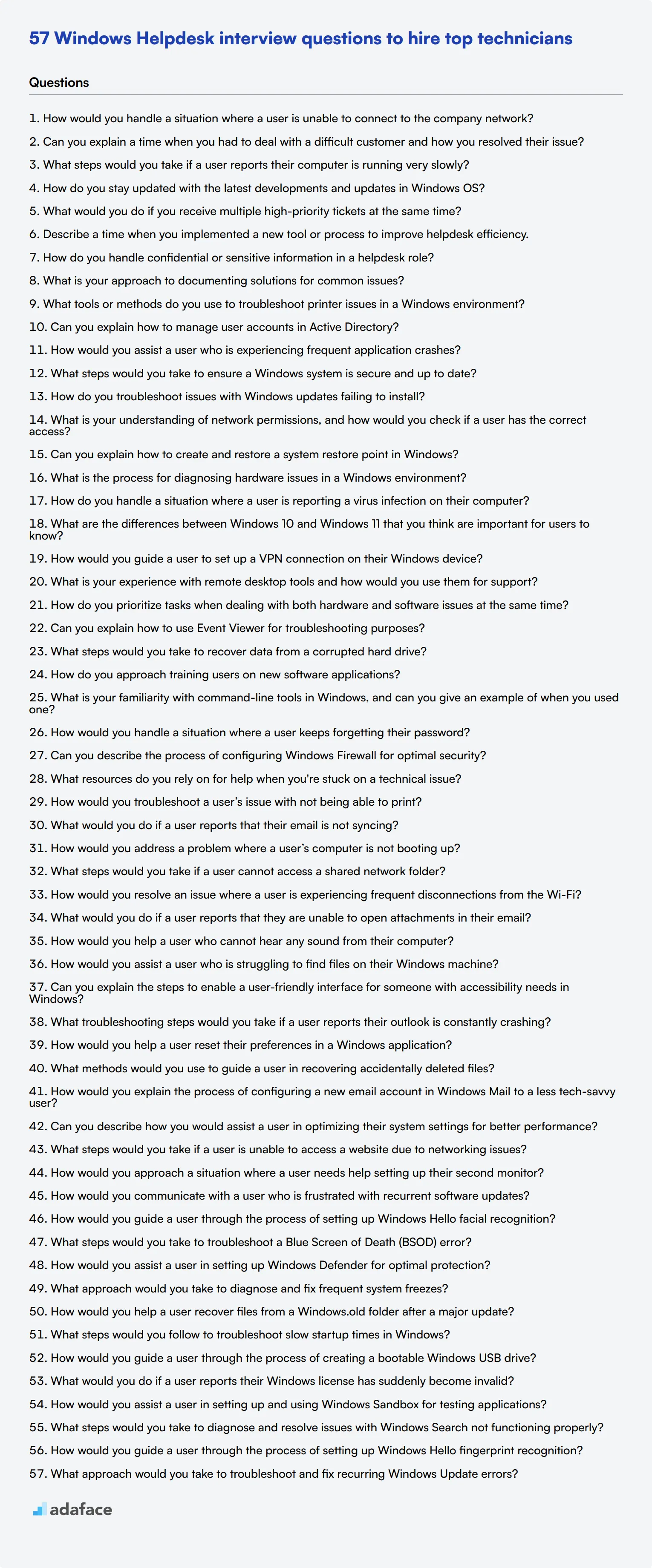Recruiting the right Windows Helpdesk technician can be challenging, but asking the right interview questions can make all the difference. Well-prepared questions help in identifying skills and traits that make good helpdesk technicians, ensuring you hire the right candidate who can handle the job effectively.
This blog post contains specific interview questions focusing on different aspects of the Windows Helpdesk role. It is divided into sections covering technical troubleshooting, user support, and situational scenarios to give a comprehensive overview.
By using these interview questions, you can streamline your hiring process and ensure a better fit for your team. Combining this with our technical support test can further enhance the accuracy of your selection.
Table of contents
Top 8 Windows Helpdesk questions to ask in interviews
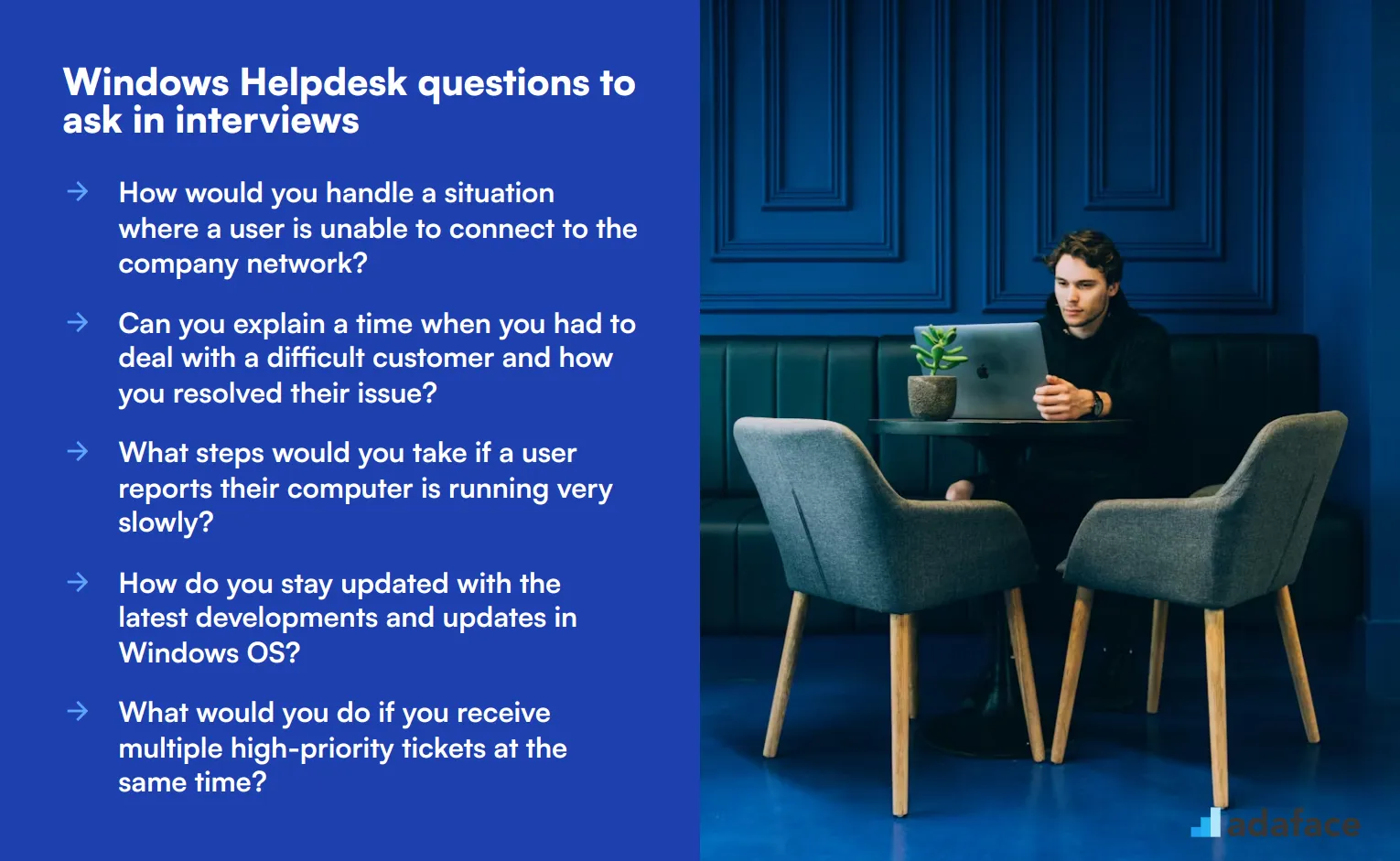
To ensure you’re hiring the best Windows Helpdesk professionals, use these top questions in your interviews. They’re crafted to gauge both technical understanding and problem-solving skills, making your selection process smoother and more effective.
1. How would you handle a situation where a user is unable to connect to the company network?
First, I would verify if the issue is specific to that user or if it affects multiple users. This helps determine if the problem is with the individual’s machine or a broader network issue.
Next, I would check the user's network settings, ensure they have the correct credentials, and look into any potential hardware issues, like a faulty cable or network card. If necessary, I’d escalate the issue to the network administrator for further investigation.
Look for candidates who systematically troubleshoot, show patience, and have a clear escalation path. Follow up to understand how they differentiate between user-specific and network-wide issues.
2. Can you explain a time when you had to deal with a difficult customer and how you resolved their issue?
In my previous role, I had a customer who was very frustrated because they couldn’t access their email. I remained calm and listened to their concerns, which helped de-escalate the situation.
I guided them step-by-step to check their email settings and clear their cache, which eventually resolved the issue. They were very appreciative of my patience and thoroughness.
Ideal candidates should demonstrate empathy, excellent communication skills, and the ability to remain calm under pressure. Look for their problem-solving strategy and how they handle high-stress scenarios.
3. What steps would you take if a user reports their computer is running very slowly?
First, I would check for any background processes or applications that may be consuming too much CPU or memory. This includes looking at the Task Manager to see what’s running.
Next, I would perform basic maintenance tasks like clearing temporary files, running a disk cleanup, and checking for malware or viruses. If needed, I’d recommend an upgrade of hardware components.
Candidates should show a methodical approach to diagnosing performance issues and mention routine maintenance tasks. Follow up to see if they consider both software and hardware factors.
4. How do you stay updated with the latest developments and updates in Windows OS?
I regularly follow tech blogs, subscribe to newsletters from Microsoft, and participate in online forums and communities related to Windows OS.
Additionally, I take part in webinars and attend industry conferences whenever possible to stay current with the latest trends and updates.
Look for candidates who proactively seek knowledge and show a genuine interest in staying updated. Ask for examples of recent updates they've implemented or learned about.
5. What would you do if you receive multiple high-priority tickets at the same time?
I would quickly assess the urgency and impact of each ticket. Tickets impacting business-critical operations would be prioritized first.
Next, I would communicate with users to inform them of the expected response time and triage the tickets accordingly. If needed, I’d request additional support from colleagues.
Ideal responses should show an ability to prioritize tasks effectively and communicate clearly with stakeholders. Follow up on how they manage stress and maintain efficiency.
6. Describe a time when you implemented a new tool or process to improve helpdesk efficiency.
At my previous job, I introduced a ticketing system that streamlined our workflow and improved response times. I trained the team on how to use it effectively.
This implementation reduced the number of unresolved tickets and improved overall customer satisfaction as we could track and manage issues more efficiently.
Evaluate whether candidates have experience with process improvement and are proactive in seeking solutions. Ask about the specific outcomes of their implementation.
7. How do you handle confidential or sensitive information in a helpdesk role?
I always adhere to company policies and industry regulations regarding data privacy. For instance, I ensure that all sensitive information is encrypted and only accessible to authorized personnel.
I also educate users on best practices for safeguarding their information and regularly review security protocols to ensure compliance.
Candidates should demonstrate a strong understanding of data security and confidentiality. Follow up to see how they balance security with user convenience.
8. What is your approach to documenting solutions for common issues?
I believe in creating clear, detailed documentation for common issues. This includes step-by-step guides and troubleshooting tips, which can be easily accessed by team members.
Having a well-documented knowledge base not only helps in resolving recurring issues faster but also serves as a training resource for new team members.
Look for a candidate who understands the importance of documentation and has experience creating and maintaining it. Ask for examples of documentation they’ve created in the past.
20 Windows Helpdesk interview questions to ask junior technicians
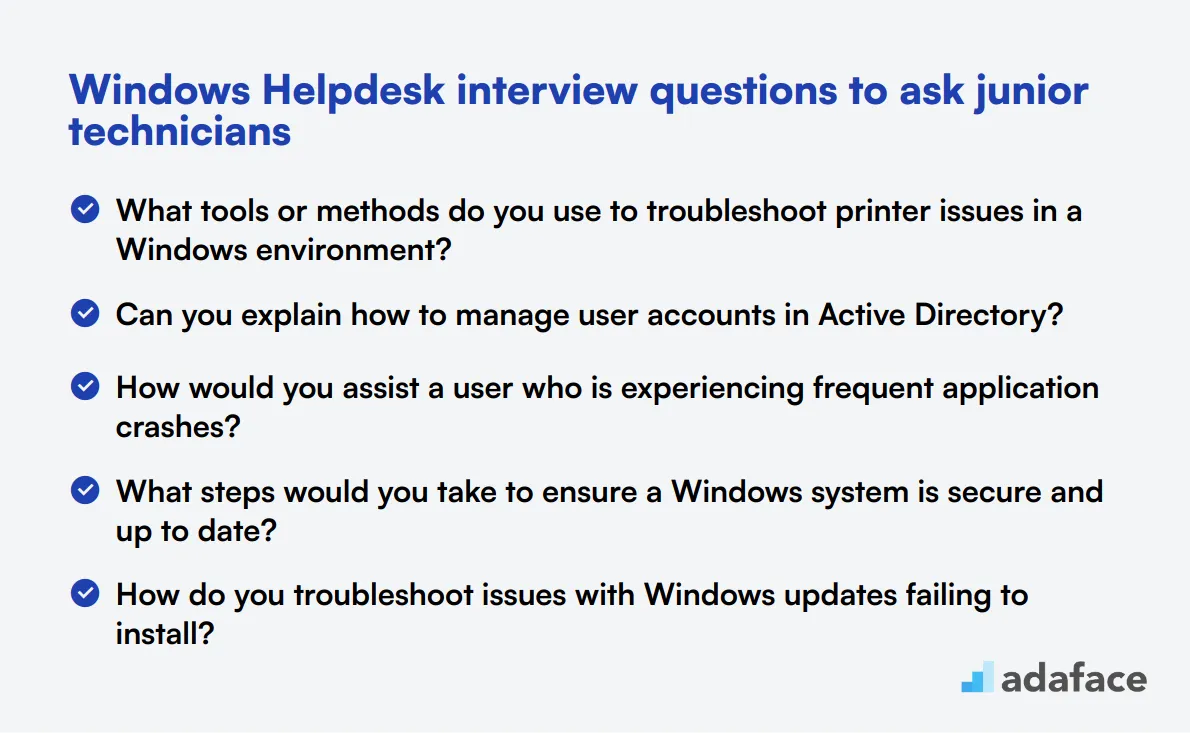
To assess whether your candidates possess the essential skills and knowledge for a Windows Helpdesk role, consider using this list of targeted interview questions. These questions will help you dig deeper into their problem-solving abilities and technical understanding, guiding you to make informed hiring decisions. For more insights, you can also check our help desk technician job description.
- What tools or methods do you use to troubleshoot printer issues in a Windows environment?
- Can you explain how to manage user accounts in Active Directory?
- How would you assist a user who is experiencing frequent application crashes?
- What steps would you take to ensure a Windows system is secure and up to date?
- How do you troubleshoot issues with Windows updates failing to install?
- What is your understanding of network permissions, and how would you check if a user has the correct access?
- Can you explain how to create and restore a system restore point in Windows?
- What is the process for diagnosing hardware issues in a Windows environment?
- How do you handle a situation where a user is reporting a virus infection on their computer?
- What are the differences between Windows 10 and Windows 11 that you think are important for users to know?
- How would you guide a user to set up a VPN connection on their Windows device?
- What is your experience with remote desktop tools and how would you use them for support?
- How do you prioritize tasks when dealing with both hardware and software issues at the same time?
- Can you explain how to use Event Viewer for troubleshooting purposes?
- What steps would you take to recover data from a corrupted hard drive?
- How do you approach training users on new software applications?
- What is your familiarity with command-line tools in Windows, and can you give an example of when you used one?
- How would you handle a situation where a user keeps forgetting their password?
- Can you describe the process of configuring Windows Firewall for optimal security?
- What resources do you rely on for help when you're stuck on a technical issue?
7 Windows Helpdesk interview questions and answers related to technical troubleshooting
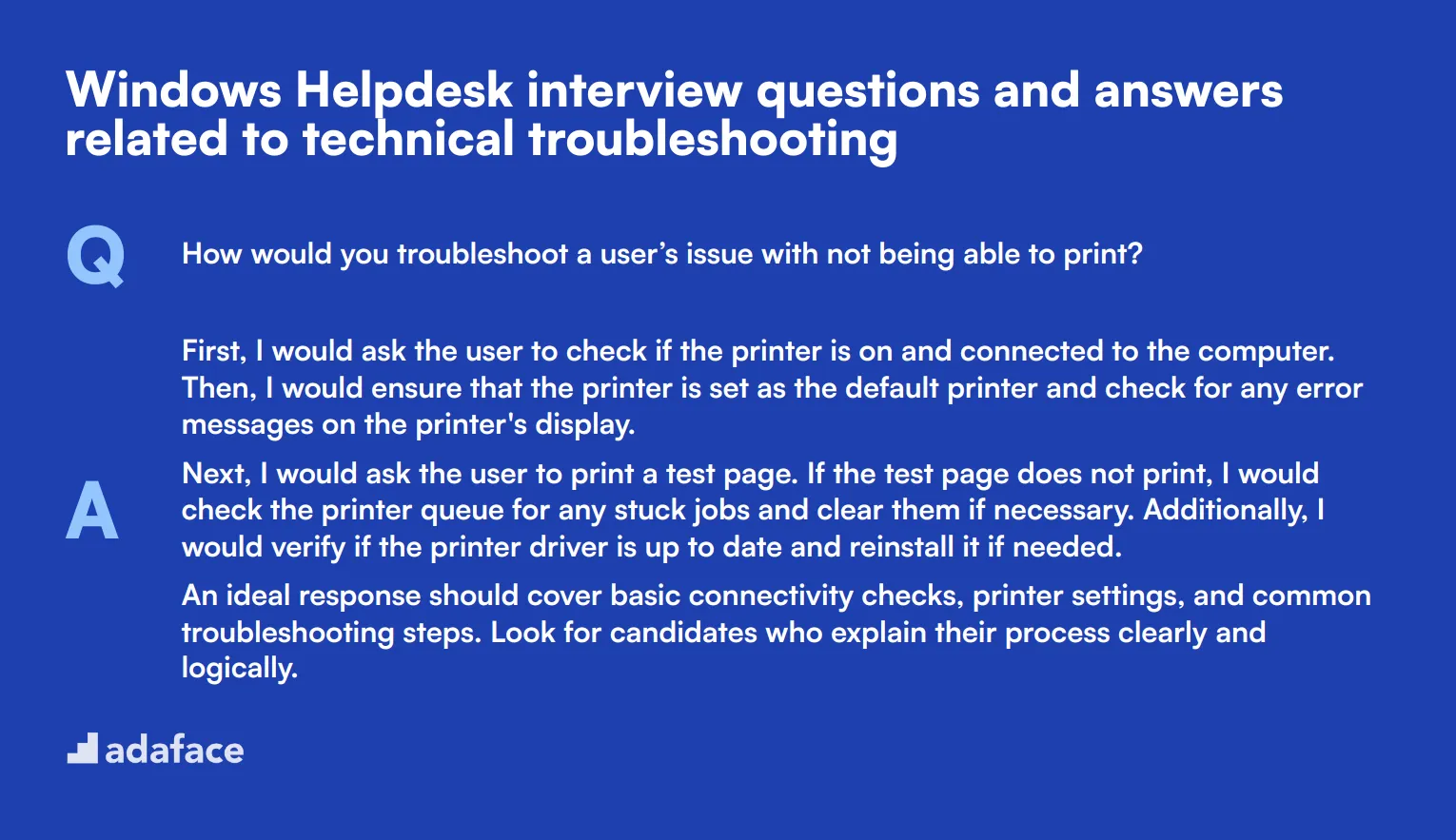
To assess your applicants' technical troubleshooting skills, use these Windows Helpdesk interview questions. These questions are designed to help you gauge how candidates approach and resolve common technical issues encountered in a Windows environment.
1. How would you troubleshoot a user’s issue with not being able to print?
First, I would ask the user to check if the printer is on and connected to the computer. Then, I would ensure that the printer is set as the default printer and check for any error messages on the printer's display.
Next, I would ask the user to print a test page. If the test page does not print, I would check the printer queue for any stuck jobs and clear them if necessary. Additionally, I would verify if the printer driver is up to date and reinstall it if needed.
An ideal response should cover basic connectivity checks, printer settings, and common troubleshooting steps. Look for candidates who explain their process clearly and logically.
2. What would you do if a user reports that their email is not syncing?
First, I would ask the user to check their internet connection to ensure it is stable. Then, I would verify that their email account settings are correctly configured, including the server settings and login credentials.
If the issue persists, I would ask the user to restart their email client and, if necessary, their device. Additionally, I would check for any updates or patches for the email client and apply them if available. If the problem still exists, I would look into the email server status to see if there are any ongoing issues.
A strong candidate should mention checking both the user's settings and the server status. They should also be able to explain the importance of verifying network connectivity and software updates.
3. How would you address a problem where a user’s computer is not booting up?
First, I would ask the user to check if the power cable and other connections are secure. If the computer still does not power on, I would ask them to try a different power outlet or use a different power cable.
If the computer powers on but does not boot into the operating system, I would guide the user to boot into Safe Mode. In Safe Mode, I would check for any recent hardware or software changes that could have caused the issue and undo those changes if possible. I would also run a system scan to check for any corrupted files.
Look for candidates who demonstrate a methodical approach to troubleshooting power and boot issues. They should be able to explain how to utilize Safe Mode and identify potential causes of the problem.
4. What steps would you take if a user cannot access a shared network folder?
First, I would verify that the user is connected to the network. Then, I would check the user’s network permissions to ensure they have the necessary access rights to the shared folder.
Next, I would ask the user to type the network path directly into the File Explorer address bar to see if they can access it that way. If the issue persists, I would check if other users can access the shared folder to determine if it's a user-specific problem or a network-wide issue.
Strong responses should include checking network connectivity, permissions, and troubleshooting steps. Candidates should also mention verifying if the issue is isolated to one user or affecting multiple users.
5. How would you resolve an issue where a user is experiencing frequent disconnections from the Wi-Fi?
I would start by asking the user to move closer to the Wi-Fi router to see if the signal strength improves. If the disconnection continues, I would check if other devices are experiencing the same issue to rule out the router.
I would also ask the user to restart their router and device. If the problem persists, I would check the Wi-Fi adapter settings on the user's device and ensure that it’s not set to save power, which could cause disconnections. Additionally, I would update the Wi-Fi adapter driver if needed.
Candidates should highlight their ability to isolate the problem, test different variables, and ensure hardware and software settings are correctly configured. Look for a step-by-step approach in their response.
6. What would you do if a user reports that they are unable to open attachments in their email?
First, I would ask the user to verify if they are receiving any error messages when trying to open the attachments. If they are, I would troubleshoot based on the specific error message.
If no error messages are displayed, I would check if the email client or webmail service has any restrictions on attachment types. I would also ensure that the user’s antivirus software is not blocking the attachments. If the problem continues, I would ask the user to try opening the attachments on a different device to see if the issue is specific to their current device.
A thorough response should include checking for error messages, potential restrictions, and antivirus settings. Candidates should demonstrate logical problem-solving and a methodical approach to troubleshooting.
7. How would you help a user who cannot hear any sound from their computer?
First, I would ask the user to check if the volume is turned up and not muted. Then, I would check if the correct playback device is selected in the sound settings.
Next, I would ask the user to test the sound output with different audio sources, such as a video or music file. If there is still no sound, I would check for any updates to the audio driver and reinstall it if necessary. Additionally, I would ensure that no external devices, like headphones, are interfering with the sound output.
Strong candidates should cover basic sound settings, driver updates, and checking for potential hardware issues. Look for clear and logical troubleshooting steps in their response.
10 Windows Helpdesk interview questions about user support
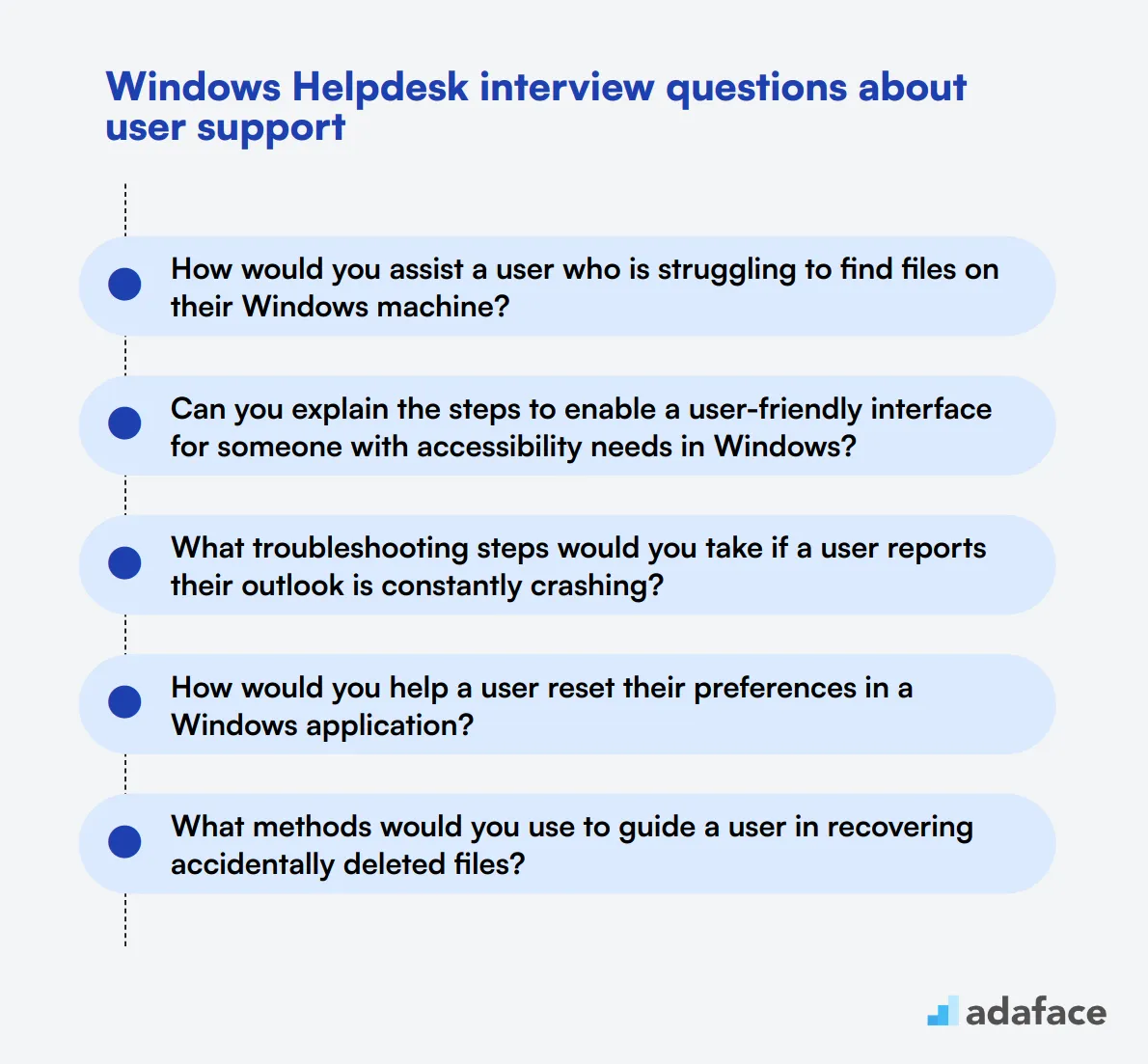
When interviewing candidates for a Windows Helpdesk role, it’s essential to gauge their user support skills effectively. Use this list of targeted questions to explore their problem-solving abilities and customer service approach. These questions will help you identify if they possess the necessary skills for a dynamic helpdesk environment, ensuring you find the right fit for your team’s needs.
- How would you assist a user who is struggling to find files on their Windows machine?
- Can you explain the steps to enable a user-friendly interface for someone with accessibility needs in Windows?
- What troubleshooting steps would you take if a user reports their outlook is constantly crashing?
- How would you help a user reset their preferences in a Windows application?
- What methods would you use to guide a user in recovering accidentally deleted files?
- How would you explain the process of configuring a new email account in Windows Mail to a less tech-savvy user?
- Can you describe how you would assist a user in optimizing their system settings for better performance?
- What steps would you take if a user is unable to access a website due to networking issues?
- How would you approach a situation where a user needs help setting up their second monitor?
- How would you communicate with a user who is frustrated with recurrent software updates?
12 situational Windows Helpdesk interview questions for hiring top technicians
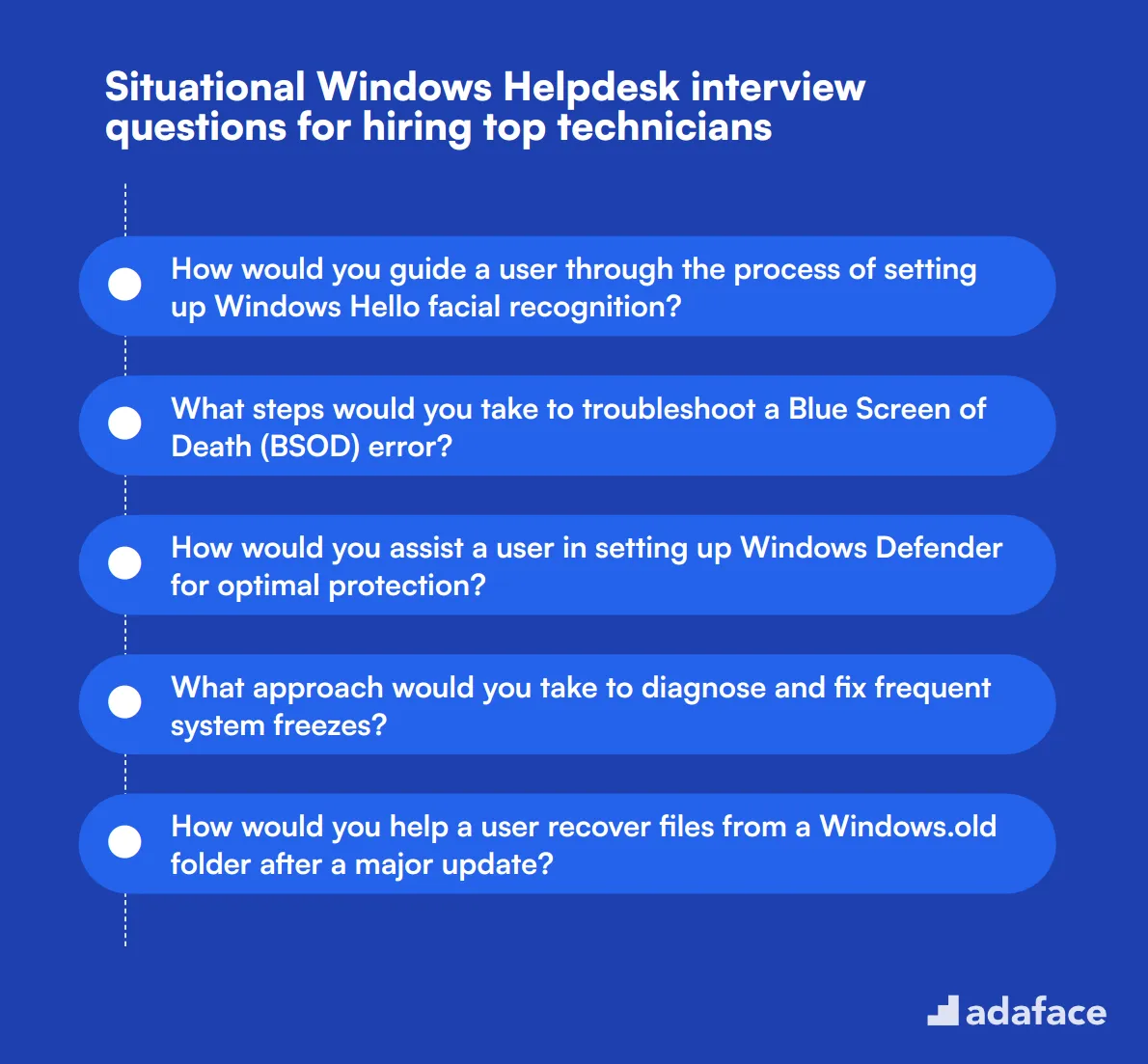
To assess a candidate's practical problem-solving abilities and Windows expertise, use these situational interview questions. They help evaluate how applicants handle real-world scenarios, providing insight into their technical skills and customer service approach.
- How would you guide a user through the process of setting up Windows Hello facial recognition?
- What steps would you take to troubleshoot a Blue Screen of Death (BSOD) error?
- How would you assist a user in setting up Windows Defender for optimal protection?
- What approach would you take to diagnose and fix frequent system freezes?
- How would you help a user recover files from a Windows.old folder after a major update?
- What steps would you follow to troubleshoot slow startup times in Windows?
- How would you guide a user through the process of creating a bootable Windows USB drive?
- What would you do if a user reports their Windows license has suddenly become invalid?
- How would you assist a user in setting up and using Windows Sandbox for testing applications?
- What steps would you take to diagnose and resolve issues with Windows Search not functioning properly?
- How would you guide a user through the process of setting up Windows Hello fingerprint recognition?
- What approach would you take to troubleshoot and fix recurring Windows Update errors?
Which Windows Helpdesk skills should you evaluate during the interview phase?
While it's challenging to assess every aspect of a candidate in a single interview, focusing on core Windows Helpdesk skills is crucial. These key competencies form the foundation for success in this role and should be prioritized during the evaluation process.
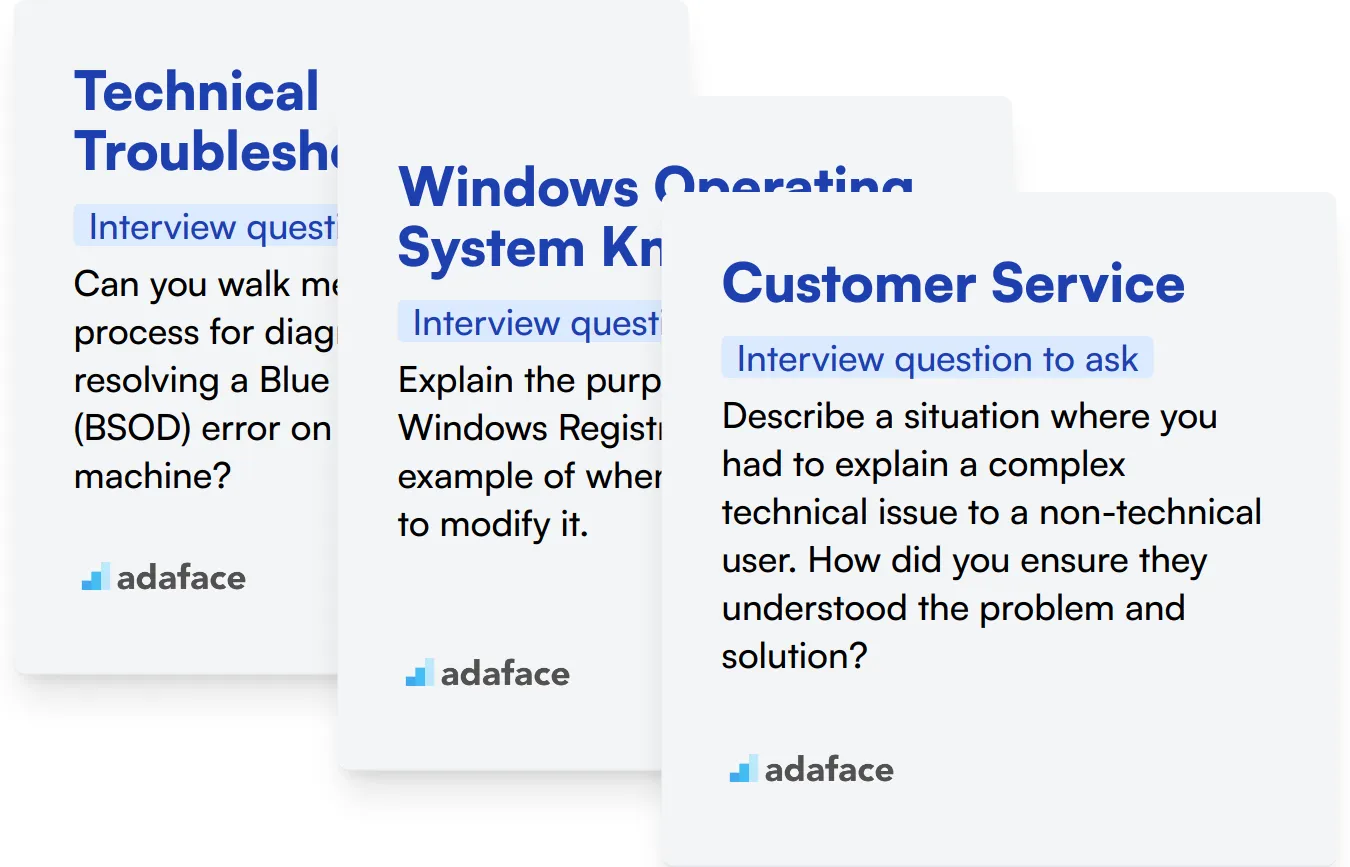
Technical Troubleshooting
Technical troubleshooting is at the heart of Windows Helpdesk work. It involves diagnosing and resolving various software and hardware issues that users encounter daily.
To evaluate this skill, consider using an assessment test with relevant MCQs. This can help filter candidates based on their troubleshooting knowledge and approach.
During the interview, ask targeted questions to gauge the candidate's troubleshooting abilities. Here's an example:
Can you walk me through your process for diagnosing and resolving a Blue Screen of Death (BSOD) error on a Windows 10 machine?
Look for candidates who mention steps like checking error codes, reviewing recent system changes, running diagnostic tools, and considering hardware issues. A structured approach and attention to detail are key indicators of strong troubleshooting skills.
Windows Operating System Knowledge
A deep understanding of Windows operating systems is essential for helpdesk technicians. This knowledge enables them to navigate system settings, use administrative tools, and provide accurate solutions.
Consider incorporating a Windows administration test to assess candidates' knowledge of Windows features, tools, and best practices.
To evaluate this skill during the interview, you can ask specific questions about Windows functionalities. For example:
Explain the purpose of the Windows Registry and provide an example of when you might need to modify it.
Look for answers that demonstrate an understanding of the Registry's role in storing configuration settings. Candidates should also mention the importance of caution when making changes and possibly reference using tools like regedit.
Customer Service
Excellent customer service skills are crucial for Windows Helpdesk technicians. They must communicate technical information clearly, remain patient, and ensure user satisfaction throughout the support process.
To assess customer service aptitude, consider using a customer service test that evaluates communication skills and problem-solving abilities in a support context.
During the interview, ask questions that reveal the candidate's approach to customer interactions. Here's an example:
Describe a situation where you had to explain a complex technical issue to a non-technical user. How did you ensure they understood the problem and solution?
Look for responses that highlight clear communication, use of analogies or simplified explanations, and patience in ensuring user comprehension. Candidates who mention confirming understanding and following up demonstrate strong customer service orientation.
Hire top talent with Windows Helpdesk skills tests and the right interview questions
When hiring for Windows Helpdesk roles, it's important to ensure that candidates possess the necessary skills. A thorough assessment can help you identify those who can effectively manage user support and technical troubleshooting.
The best way to accurately evaluate these skills is through targeted skill tests. Consider using our Windows System Administration Online Test or the Technical Support Test to assess candidates thoroughly.
Once you have conducted the tests, you can shortlist the best applicants who meet your criteria. This step will make your interview process much more efficient and focused on candidates who are truly capable.
To take the next step in hiring top Windows Helpdesk talent, visit our assessment test library to explore more tests and sign up for our platform. Streamline your hiring process and find the right candidates with ease.
Windows System Administration Online Test
Download Windows Helpdesk interview questions template in multiple formats
Windows Helpdesk Interview Questions FAQs
They help assess a candidate's technical and customer support skills, ensuring they can handle real-world scenarios effectively.
Look for problem-solving abilities, technical knowledge of Windows systems, effective communication, and customer support experience.
Ask technical troubleshooting questions and situational questions to see how they approach and resolve issues.
These questions present hypothetical scenarios to candidates to assess how they would handle real-world problems and challenges.
Familiarize yourself with the technical aspects of Windows systems and practice common troubleshooting scenarios.
While prior experience is beneficial, it's also important to assess their potential for learning and adapting to new challenges.

40 min skill tests.
No trick questions.
Accurate shortlisting.
We make it easy for you to find the best candidates in your pipeline with a 40 min skills test.
Try for freeRelated posts
Free resources




